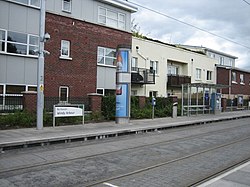Windy Arbour
| Windy Arbour Irish: Na Glasáin | |
| County Dublin | |
|---|---|
 Windy Arbour Luas stop | |
| Location | |
| Grid reference: | O169295 |
| Location: | 53°18’10"N, 6°14’49"W |
| Data | |
| Postcode: | D14 |
| Local Government | |
| Council: | Dún Laoghaire–Rathdown |
Windy Arbour is a small, suburban village in the area of Dundrum in County Dublin. It is to be found between Dundrum and Milltown, along the banks of the Slang River (also known as the Dundrum or Slann River).
History
The name of the area was originally Irish Na Glasáin, "the green land"; this was Anglicised as 'Glassons'. The name Windy Harbour or Sandy Arbour was later applied, referring to a landing-point on the River Slang.
A starch mill was formerly located here.[1] "Arbour" once had the meaning "grass plot, lawn, garden"; it is possible that the name was intended as a direct translation of glasáin.[2]

Perhaps the most famous person to live in Windy Arbour was Irish rebel Robert Emmet, who grew up in The Casino, a manor house that is now known as Emmet House, where the Secretariat of Secondary schools in Ireland is currently housed. It is located next to the Roman Catholic church on Bird Avenue and was formerly known as Carton House.
The Central Mental Hospital is located beside the village and was built c.1850.[3] The hospital provides treatment in high, low, and medium security conditions. Patients are referred by the courts, the prisons and local hospitals for both assessment and residential treatment.
Housing
Windy Arbour is surrounded by several housing estates. At the centre of Windy Arbour is the smaller and much older townland of Farranboley, which appears on maps dating from the 18th century.
References
- ↑ "Cobbett's Complete Collection of State Trials and Proceedings for High Treason and Other Crimes and Misdemeanors from the Earliest Period to the Present Time: With Notes and Other Illustrations". Bagshaw. June 17, 1820. https://books.google.com/books?id=VrdCAAAAcAAJ&q=%22windy+harbour%22&pg=PA463.
- ↑ "Na Glasáin/Windy Arbour". https://www.logainm.ie/en/127120.
- ↑ "Central Mental Hospital, Dundrum Road, CHURCHTOWN LOWER, Dundrum, Dún Laoghaire-Rathdown". https://www.buildingsofireland.ie/buildings-search/building/60220001/central-mental-hospital-dundrum-road-churchtown-lower-dundrum-co-dun-laoghaire-rathdown.